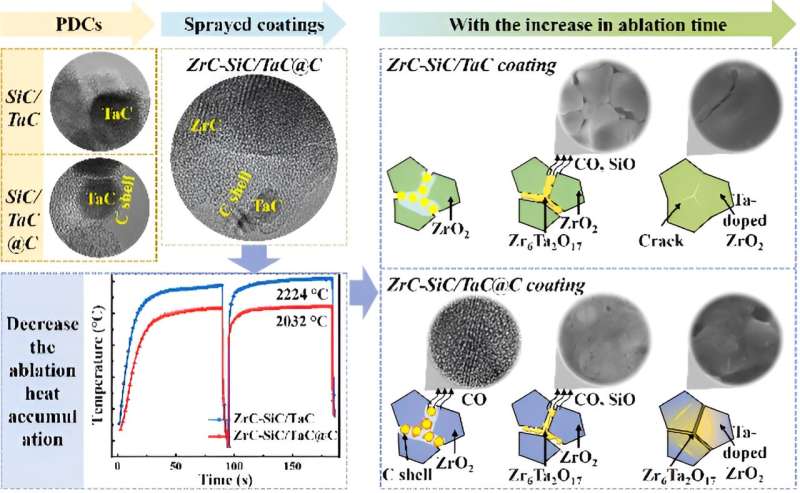This article has been reviewed according to Science X's editorial process and policies. Editors have highlighted the following attributes while ensuring the content's credibility:
fact-checked
proofread
High heat dissipation design improves thermal protection on ultrahigh temperature ablation

ZrC has drawn wide attention as an anti-ablation coating material for lightweight C/C composites but is limited by the produced porous and loose ZrO2 film. To address this issue, the second phase is introduced to improve the densification of the formed Zr-X-O film. Such as ZrC-SiC/TaC coating, the produced low-melting-point oxides, SiO2 (Tm=1650 °C), Ta2O5 (Tm=1800 °C) and Zr6Ta2O17 (Tm=1900 °C), helped to form a dense oxides film.
However, the high service temperature causes heat accumulation and a large thermal stress gradient on the surface of the coatings, which will result in large local defects and accelerate the failure of the coating.
To decrease the ablation heat accumulation, incorporating nanomaterials with high thermal conductivity is an effective strategy but is limited in practical applications due to agglomeration. A core–shell structure is advantageous because it can endow the outer carbon shell with good dispersion and a thermal conduction network. However, achieving a uniformly dispersed core–shell structure within a dense coating remains challenging due to structural retention difficulty that is limited by complex preparation processes.
Recently, a team from Northwestern Polytechnical University, China, constructed polymer-derived SiC/TaC with a graphene shell, and prepared a corresponding dense ZrC-SiC/TaC@C coating. This work not only explains the heat dissipation effect of carbon shell in ZrC–SiC/TaC coating on improving its protective ability against ultrahigh temperature ablation, but also provides a constructive idea that the ablation resistance improvement can be improved by incorporating carbon nanomaterials.
The team published their work in Journal of Advanced Ceramics on July 30, 2024.
"In this report, we designed and constructed a thermally conductive nanonetwork with a ceramic@carbon core–shell structure. Polymer-derived SiC/TaC with a graphene carbon shell was synthesized and introduced into a ZrC coating by supersonic atmospheric plasma spraying. Incorporating carbon nanomaterials with high thermal conductivity could reduce the surface temperature of ablation coatings and then decrease the ablation heat accumulation.
"The surface temperatures of the ZrC–SiC/TaC@C and ZrC–SiC/TaC coatings reach 2032 and 2224 °C, respectively, corresponding to a temperature difference of nearly 200 °C. Compared with that of the ZrC–SiC/TaC coating, the Rl of the ZrC–SiC/TaC@C coating is lower, at only 0.009 μm/s, a decrease of 93.7%," said Jia Sun, from School of Materials at Northwestern Polytechnical University (China), a senior expert whose research interests focus on the field of high-temperature ceramics material.
Other contributors include Yuyu Zhang, Xuemeng Zhang, Hongkang Ou, Qiangang Fu from the School of Materials at Northwestern Polytechnical University in Xi'an, China; Bozhe Wang from the System Design Institute of Hubei Aerospace Technology Academy in Wuhan, China.
More information: Yuyu Zhang et al, Heat dissipation of carbon shell in ZrC–SiC/TaC coating to improve protective ability against ultrahigh temperature ablation, Journal of Advanced Ceramics (2024). DOI: 10.26599/JAC.2024.9220921
Provided by Tsinghua University Press




















